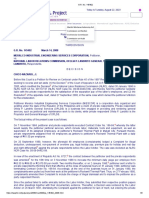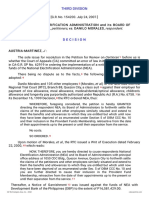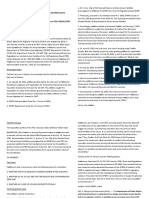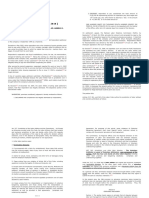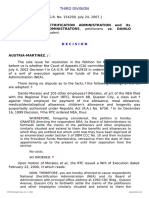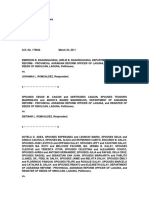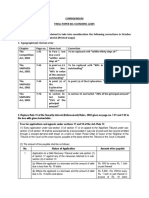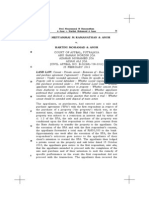FIRST DIVISION G.R. No. 152845 August 5, 2003 DRIANITA BAGAOISAN, FELY MADRIAGA, SHIRLY TAGABAN, RICARDO SARANDI, SUSAN IMPERIAL, BENJAMIN DEMDEM, RODOLFO DAGA, EDGARDO BACLIG, GREGORIO LABAYAN, HILARIO JEREZ, and MARIA CORAZON CUANANG, Petitioners, vs. NATIONAL TOBACCO ADMINISTRATION, represented by ANTONIO DE GUZMAN and PERLITA BAULA, Respondents.
D E C I S I O N VITUG, J.: President Joseph Estrada issued on 30 September 1998 Executive Order No. 29, entitled "Mandating the Streamlining of the National Tobacco Administration (NTA)," a government agency under the Department of Agriculture. The order was followed by another issuance, on 27 October 1998, by President Estrada of Executive Order No. 36, amending Executive Order No. 29, insofar as the new staffing pattern was concerned, by increasing from four hundred (400) to not exceeding seven hundred fifty (750) the positions affected thereby. In compliance therewith, the NTA prepared and adopted a new Organization Structure and Staffing Pattern (OSSP) which, on 29 October 1998, was submitted to the Office of the President. On 11 November 1998, the rank and file employees of NTA Batac, among whom included herein petitioners, filed a letter-appeal with the Civil Service Commission and sought its assistance in recalling the OSSP. On 04 December 1998, the OSSP was approved by the Department of Budget and Management (DBM) subject to certain revisions. On even date, the NTA created a placement committee to assist the appointing authority in the selection and placement of permanent personnel in the revised OSSP. The results of the evaluation by the committee on the individual qualifications of applicants to the positions in the new OSSP were then disseminated and posted at the central and provincial offices of the NTA. On 10 June 1996, petitioners, all occupying different positions at the NTA office in Batac, Ilocos Norte, received individual notices of termination of their employment with the NTA effective thirty (30) days from receipt thereof. Finding themselves without any immediate relief from their dismissal from the service, petitioners filed a petition for certiorari, prohibition and mandamus, with prayer for preliminary mandatory injunction and/or temporary restraining order, with
the Regional Trial Court (RTC) of Batac, Ilocos Norte, and prayed - "1) that a restraining order be immediately issued enjoining the respondents from enforcing the notice of termination addressed individually to the petitioners and/or from committing further acts of dispossession and/or ousting the petitioners from their respective offices; "2) that a writ of preliminary injunction be issued against the respondents, commanding them to maintain the status quo to protect the rights of the petitioners pending the determination of the validity of the implementation of their dismissal from the service; and "3) that, after trial on the merits, judgment be rendered declaring the notice of termination of the petitioners illegal and the reorganization null and void and ordering their reinstatement with backwages, if applicable, commanding the respondents to desist from further terminating their services, and making the injunction permanent."1 The RTC, on 09 September 2000, ordered the NTA to appoint petitioners in the new OSSP to positions similar or comparable to their respective former assignments. A motion for reconsideration filed by the NTA was denied by the trial court in its order of 28 February 2001. Thereupon, the NTA filed an appeal with the Court of Appeals, raising the following issues: "I. Whether or not respondents submitted evidence as proof
that petitioners, individually, were not the ‘best qualified and most deserving’ among the incumbent applicant
-employees. "II. Whether or not incumbent permanent employees, including herein petitioners, automatically enjoy a preferential right and the right of first refusal to appointments/reappointments in the new Organization Structure And Staffing Pattern (OSSP) of respondent NTA. "III. Whether or not respondent NTA in implementing the mandated reorganization pursuant to E.O. No. 29, as amended by E.O. No. 36, strictly adhere to the implementing rules on reorganization, particularly RA 6656 and of the Civil Service Commission
–
Rules on Government Reorganization. "IV. Whether or not the validity of E.O. Nos. 29 and 36 can be put in issue in the instant case/appeal."2 On 20 February 2002, the appellate court rendered a decision reversing and setting aside the assailed orders of the trial court. Petitioners went to this Court to assail the decision of the Court of Appeals, contending that -
"I. The Court of Appeals erred in making a finding that went beyond the issues of the case and which are contrary to those of the trial court and that it overlooked certain relevant facts not disputed by the parties and which, if properly considered, would justify a different conclusion; "II. The Court of Appeals erred in upholding Executive Order Nos. 29 and 36 of the Office of the President which are mere administrative issuances which do not have the force and effect of a law to warrant abolition of positions and/or effecting total reorganization;
"III. The Court of Appeals erred in holding that petitioners’
removal from the service is in accordance with law; "IV. The Court of Appeals erred in holding that respondent NTA was not guilty of bad faith in the termination of the services of petitioners; (and) "V. The Court of Appeals erred in ignoring case law/jurisprudence in the abolition of an office."3 In its resolution of 10 July 2002, the Court required the NTA to file its comment on the petition. On 18 November 2002, after the NTA had filed its comment of 23 September 2002, the Court issued its resolution denying the petition for failure of petitioners to sufficiently show any reversible error on the part of the appellate court in its challenged decision so as to warrant the exercise by this Court of its discretionary appellate jurisdiction. A motion for reconsideration filed by petitioners
was denied in the Court’s resolution of 20 January 2002.
On 21 February 2003, petitioners submitted a "Motion to Admit Petition For En Banc Resolution" of the case allegedly to address a basic question, i.e., "the legal and constitutional issue on whether the NTA may be reorganized by an executive fiat, not by legislative action."4 In their "Petition for an En Banc Resolution" petitioners would have it that -
"1. The Court of Appeals’ decision upholding the reorganization
of the National Tobacco Administration sets a dangerous precedent in that:
"’a) A mere Executive Order issued by the Office of the
President and procured by a government functionary would have the effect of a blanket authority to reorganize a bureau, office or agency attached to the various executive departments;
‘b) The President of the Philippines would have the plenary
power to reorganize the entire government Bureaucracy through the issuance of an Executive Order, an administrative issuance without the benefit of due deliberation, debate and
discussion of members of both chambers of the Congress of the Philippines;
‘c) The right
to security of tenure to a career position created by law or statute would be defeated by the mere adoption of an Organizational Structure and Staffing Pattern issued pursuant to an Executive Order which is not a law and could thus not abolish an office created by law; "2. The case law on abolition of an office would be disregarded, ignored and abandoned if the Court of Appeals decision subject matter of this Petition would remain undisturbed and untouched. In other words, previous doctrines and precedents of this Highest Court would in effect be reversed and/or modified with the Court of Appeals judgment, should it remain unchallenged. "3. Section 4 of Executive Order No. 245 dated July 24, 1987
(Annex ‘D,’ Petition), issued by the Revolutionary governmen
t of former President Corazon Aquino, and the law creating NTA, which provides that the governing body of NTA is the Board of Directors, would be rendered meaningless, ineffective and a dead letter law because the challenged NTA reorganization which was erroneously upheld by the Court of Appeals was adopted and implemented by then NTA Administrator Antonio de Guzman without the corresponding authority from the Board of Directors as mandated therein. In brief, the reorganization is an ultra vires act of the NTA Administrator. "4. The challenged Executive Order No. 29 issued by former President Joseph Estrada but unsigned by then Executive Secretary Ronaldo Zamora would in effect be erroneously upheld and given legal effect as to supersede, amend and/or modify Executive Order No. 245, a law issued during the Freedom Constitution of President Corazon Aquino. In brief, a mere executive order would amend, supersede and/or render ineffective a law or statute."5 In order to allow the parties a full opportunity to ventilate their views on the matter, the Court ultimately resolved to hear the parties in oral argument. Essentially, the core question raised by them is whether or not the President, through the issuance of an executive order, can validly carry out the reorganization of the NTA. Notwithstanding the apparent procedural lapse on the part of petitioner to implead the Office of the President as party respondent pursuant to Section 7, Rule 3, of the 1997 Revised Rules of Civil Procedure, 6 this Court resolved to rule on the merits of the petition. Buklod ng Kawaning EIIB vs. Zamora7 ruled that the President, based on existing laws, had the authority to carry out a reorganization in any branch or agency of the executive department. In said case, Buklod ng Kawaning EIIB challenged the issuance, and sought the nullification, of Executive Order








